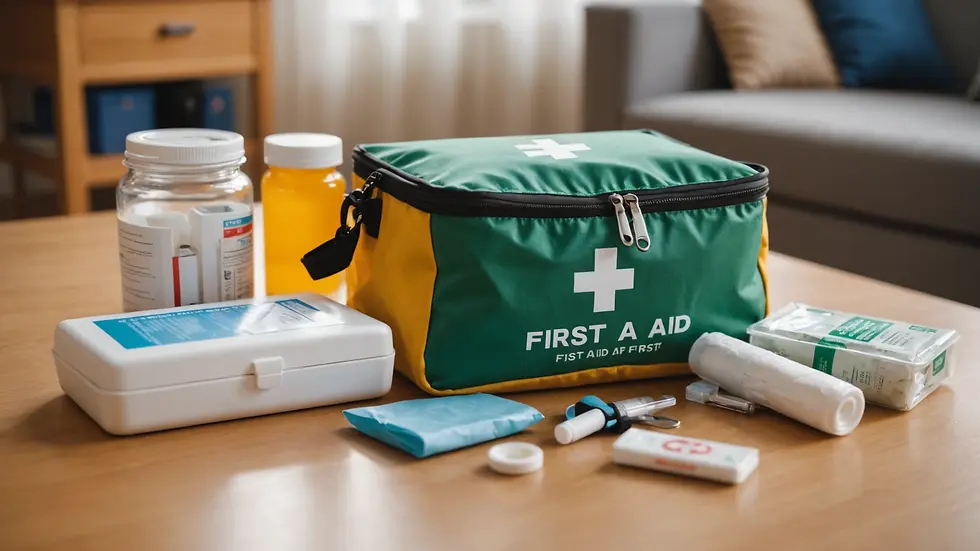What to Do When Your Cat Has a Sudden Health Emergency: A Guide for Pet Owners
- Jyotiraj Borah
- Feb 11
- 5 min read
Caring for a cat brings many joys, but nothing can be more distressing than a sudden health emergency. As a pet owner, it’s crucial to recognize emergency signals and know the right actions to take quickly. A prompt response can be life-saving. This guide aims to help you identify common cat emergencies, understand their signs, and respond effectively in those critical moments.
Understanding Common Cat Emergencies
Cats are experts at concealing pain and discomfort. However, there are specific situations that clearly indicate a health emergency requiring immediate attention. Knowing these can help you act quickly.
1. Difficulty Breathing
Respiratory distress is one of the most urgent signs of a health emergency. If your cat shows labored breathing, rapid panting, or coughing, they may suffer from serious issues like asthma or heart disease.
In this situation, try to keep your cat calm. Speak softly and move gently to avoid causing additional stress. Seek veterinary care right away. Studies show that timely intervention in cases of respiratory distress significantly improves outcomes.
2. Severe Bleeding
Severe bleeding from deep cuts or lacerations needs immediate action. For example, if your cat has a deep bite wound or a cut that reveals muscle or fat, apply pressure with a clean cloth or bandage to the area.
Transport your cat to the veterinarian promptly and note the injury's location and severity; this information can guide the vet's treatment decisions.
3. Ingesting Toxic Substances
Cats often explore the world with their mouths, which can lead to dangerous situations. Items like lilies, antifreeze, and certain human foods are toxic to them. Symptoms include vomiting and unusual behaviors.
If you suspect your cat has ingested something harmful, contact your vet or a poison control hotline immediately. Do not induce vomiting without professional guidance, as this can make the situation worse. In fact, over 1,000 cats are reported to consume toxic plants each year, highlighting the importance of vigilance.

4. Vomiting and Diarrhea
While occasional vomiting or diarrhea in cats is common, if either persists for more than 24 hours, it’s time to act. Look for signs of dehydration, like dry gums and low energy.
Monitoring your cat’s food and water intake can provide crucial information for your vet. Persistent symptoms can indicate serious conditions, such as pancreatitis, which affects around 10% of cats annually.
5. Signs of Pain
Cats express pain in various ways, such as hiding, aggression, or loss of appetite. If your cat limps, meows excessively, or hasn’t eaten all day, something is clearly wrong.
Bring your cat to the vet as soon as possible for proper diagnosis and pain management.
First Aid for Cats
While veterinary help is vital, knowing basic first aid for cats can make a difference while you seek professional care. Here are some essential first aid steps you can take:
1. Muzzle Your Cat
In emergencies, cats may act aggressively out of fear. If available, use a muzzle to protect yourself and the cat, ensuring it doesn’t restrict their breathing or swallowing.
2. Control Bleeding
If your cat is bleeding, apply a clean cloth or sterile gauze pad firmly on the wound, maintaining pressure for 5 to 10 minutes. Keep them calm, as movement can worsen the bleeding.
3. Monitor Breathing
If your cat is having trouble breathing, keep them calm while you prepare to visit the vet. Note their breathing rate and pattern; this information can be helpful for the vet.
4. Safe Handling
Handle your cat gently during emergencies. If they are injured, stabilize them without unnecessary movement, which can worsen their condition.
5. Prevent Choking
If your cat appears to be choking, assess the situation calmly. If you can see the object obstructing their throat, try to remove it carefully. If not, use the designated Heimlich maneuver for cats or head to the vet immediately.

When to Call the Vet
Knowing when to call the vet can be a matter of life and death. Here are some scenarios that warrant immediate consultation:
1. Persistent Symptoms
If your cat shows symptoms like vomiting or diarrhea for over 24 hours, seek veterinary help immediately.
2. Behavioral Changes
Sudden behavioral changes, such as aggression, hiding, or excessive vocalizations, should not be underestimated. Such changes can indicate significant distress.
3. After an Accident
If your cat has been in an accident, whether it’s a fall or an encounter with a vehicle, immediate veterinary care is crucial. Internal injuries can be life-threatening.
4. Severe Reactions
In cases of severe allergic reactions—including swelling and difficulty breathing—immediate treatment is essential. These situations can escalate rapidly and necessitate urgent care.
Preparing for Emergencies
Proper preparation can make a pivotal difference during health emergencies. Here are some easy yet effective ways to prepare:
1. Compile a First Aid Kit
Essential items for your first aid kit should include:
Gauze pads
Adhesive tape
Tweezers
Scissors
Antiseptic wipes
Syringe for administering medication
Ensure your kit is well-stocked and easily accessible.
2. Know Your Vet’s Emergency Protocol
Familiarize yourself with your vet's emergency procedures. Some clinics offer after-hours services or refer clients to emergency animal hospitals.
3. Educate Yourself
Staying informed about cat health can prepare you for common issues. Look for reliable resources to gain knowledge and confidence.
4. Keep Identification Updated
Make sure your cat has a collar with identification tags. Also, consider microchipping them, as this can aid in their recovery during emergencies. Research shows that microchipped pets are 20 times more likely to be found and returned.

Post-Emergency Actions
After navigating a health emergency, several follow-up steps are vital:
1. Follow-Up Vet Visits
Ensure you attend all follow-up appointments as directed by your veterinarian. These visits help confirm that your cat has fully recovered.
2. Observe Behavioral Changes
Monitor your cat closely after an emergency. Any ongoing signs of distress or unusual behavior should be reported to your vet.
3. Adjust Home Environment
Emergency situations can often arise from household hazards. Use this moment to assess and modify your living space, removing potential threats and securing dangerous items.
4. Stay Calm
Your cat can sense your emotions, so remaining calm helps them feel secure. This stability is crucial for their adjustment back to normalcy after a stressful experience.
Final Thoughts
Being aware of common health emergencies in cats and knowing how to respond can make a significant difference in your furry friend’s well-being. With the right knowledge and preparation, you can increase the chances of a positive outcome in critical situations.
When in doubt, it is always better to consult a veterinarian. Your proactive approach can help ensure your cat remains happy and healthy for many years. With preparation and timely assistance, navigating health emergencies can be done with confidence and care.




Commentaires